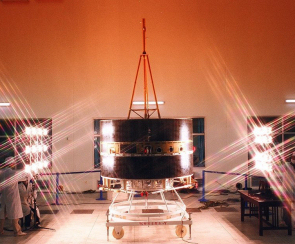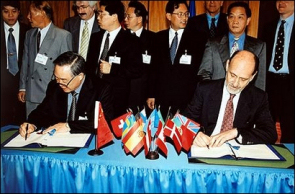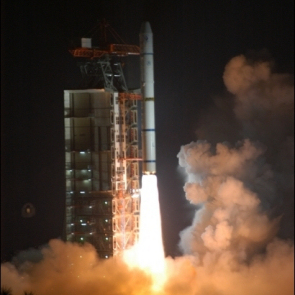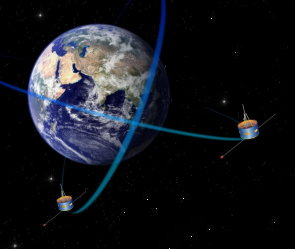Summary
 |
| The Double Star TC-2 spacecraft during Sun simulation testing. Courtesy CNSA/CAST/CSSAR |
Flying in orbits that were complementary to those followed by ESA's Cluster quartet, the Double Star duo completed a constellation of six spacecraft that was able to provide unprecedented multi-point measurements of near-Earth space. The pair's orbits were designed to complement the Cluster mission by maximising the time when both sets of spacecraft could sample the same regions at different distances from Earth.
Conducting joint studies with Cluster and Double Star was expected to increase the overall scientific return from both missions. By flying experiments identical to those on Cluster, it was possible to minimise risk, reduce costs and cut development time.
The Europe-China collaboration began with the participation of Chinese scientists in the ground-breaking Cluster mission, which began to study the Sun-Earth connection in 2000.
After an invitation by the Chinese National Space Administration (CNSA) in 1997 for ESA to participate in a Chinese mission to study near-Earth space, discussions between members of the Cluster team and their counterparts from the Centre for Space Science and Applied Research eventually resulted in a decision to develop two 'mini-Cluster' satellites.
 |
| Signing of the Double Star Agreement by Antonio Rodotà and Luan Enjie. Credit: ESA |
The historic East-West rapprochement was officially given the green light on 9 July 2001, when the ESA Director General, Antonio Rodotà, and Luan Enjie, Administrator of the CNSA, signed an agreement that enabled European experiments to be flown on Chinese satellites for the first time. The joint project was generally known as Double Star, though the Chinese name given to each satellite after launch was Tan Ce (Explorer).
Under the agreement, China would provide two spin-stabilised spacecraft, their launches and roughly half of the scientific payloads. CNSA was also in charge of spacecraft control and operation of the Chinese instruments. ESA's contribution to the mission included eight scientific instruments, of which seven were spares from the Cluster mission, and support to the ground segment for four hours each day via ESA's satellite tracking station in Villafranca, Spain.
 |
| Launch of the first Double Star spacecraft, TC-1, from China's launch site in Xichang. Copyright: CNSA/CSSAR |
 |
| Artist's impression Double Star. Credit: ESA |
Despite potentially complicating factors of distance and communication, including translation into different languages, the project proceeded more or less according to plan. The first spacecraft, TC-1, was launched on 29 December 2003 and the second one, TC-2, on 25 July 2004, both on board Chinese Long March 2C rockets. TC-1 was injected into an elliptical equatorial orbit and TC-2 into an elongated polar orbit.
Both orbits were lower than those of Cluster, ensuring that the Double Star pair was mainly flying between Cluster and the Earth. TC-2 was able to complement Cluster's observations of the polar cusps and auroral regions, while the equatorial satellite was able to investigate the solar wind and Earth's huge magnetic tail, the region where particles are accelerated towards the polar regions by a process known as magnetic re-connection.
The Double Star mission was extended twice after the successful completion of the 18 month primary science phase. The flight of TC-1 ended on 14 October 2007, when it re-entered the atmosphere, but TC-2 continued to operate intermittently until late 2008, when contact was lost.
Double Star made significant contributions to scientists' understanding of the boundaries of the magnetosphere and the fundamental processes that play a role in the transport of mass, momentum and energy into the magnetosphere.
This was made possible by placing the satellites in orbits that took them through many key plasma regions, such as the bow shock, magnetopause and near Earth plasma sheet. Other advantages were the addition of a neutral atom imager similar to one flying on ESA's Mars Express mission, and a high telemetry rate for the particle instruments, which allowed 3-D electron and ion distribution to be measured with up to 4 second time resolution.
For the first time, it was possible to study the evolution of magnetospheric structures and physical processes at small scales within the Cluster tetrahedron, and then at large scales with Double Star.
One of the more surprising results was the joint discovery by Cluster and Double Star of thousands of bubbles of superheated gas, or ion density holes, that are constantly growing then bursting at the bow shock, where Earth's magnetosphere meets the constant stream of gas from the Sun. The discovery allowed scientists to better understand the interaction between the solar wind and Earth's magnetic field.
Observations by Cluster and TC-1 showed that waves known as chorus emissions are created further away from Earth during high geomagnetic activity. This discovery was important because the waves play an important role in creating killer electrons that can damage solar panels and electronic equipment of satellites and are a hazard for astronauts. This information is crucial to be able to forecast their effects.
Cluster and Double Star spacecraft also studied widely separated sections of the neutral sheet, a key region of plasma in the centre of the magnetotail where particles are accelerated towards Earth. Similar oscillations in the neutral sheet were found to occur up to 30 000 km apart - the first time that simultaneous observations of this phenomenon had been made at two different locations in the magnetotail.
Although the Double Star spacecraft are no longer operational, their data are still being re-processed, calibrated and archived, before being included in the Cluster Science Archive.
